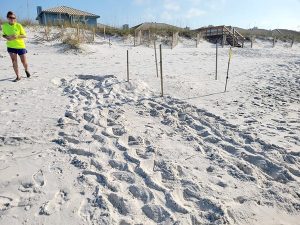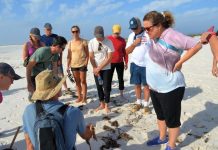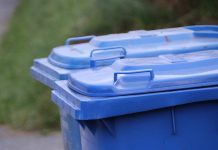Comienza la temporada de anidación de tortugas marinas
CONDADO DE ESCAMBIA, Fla. – Los voluntarios del Programa de Conservación de Tortugas Marinas del Condado de Escambia saludaron al sol temprano el 1 de mayo, al dar la bienvenida oficialmente al inicio de la temporada de anidación de tortugas marinas. El día marcó su primera patrulla matutina diaria en Pensacola Beach y Perdido Key, en busca de anidaciones y otras actividades de tortugas que ocurren durante la noche.
Los voluntarios comienzan sus patrullas con las primeras luces del día para tener mayores posibilidades de detectar huellas, nidos y otras actividades de las tortugas antes de que las huellas, el viento y las olas borren las huellas. Los voluntarios y el personal continuarán revisando los nidos durante el período de incubación, asegurándose de que permanezcan tranquilos y en espera para ayudar en caso de varamientos y otros incidentes relacionados con las tortugas. La temporada de anidación se extenderá hasta septiembre, aunque los nidos tardíos pueden eclosionar hasta octubre.
Cuatro especies de tortugas marinas anidan en el condado de Escambia. Las tortugas hembras llegarán a las playas hasta principios del verano y pueden anidar varias veces en una sola temporada.
Después de 60 días de incubación, las pequeñas tortugas recién nacidas emergerán todas a la vez al amparo de la oscuridad y correrán hacia el Golfo de México. Las crías llegarán a aguas abiertas con menos depredadores. Después de unos años de crecimiento y alimentación, regresarán al área como juveniles y subadultos. Aquí seguirán creciendo y alimentándose hasta que sean lo suficientemente maduros para aparearse y poner sus nidos. A menudo se pueden ver tortugas marinas juveniles y adultas buscando alimento en las bahías y estrechos, incluso cerca de los muelles de pesca locales y los arrecifes artificiales.
Varias especies de aves playeras también anidan en las playas locales durante los meses de verano. Los nidos de aves playeras son raspaduras poco profundas en la arena con huevos diminutos y bien camuflados. Los huevos se incubarán hasta 30 días antes de que nazcan los pequeños polluelos con forma de bolas de algodón. Los padres a menudo se sientan sobre los huevos de los polluelos recién nacidos para protegerlos de los depredadores y del cálido sol de Florida. Se pide a los bañistas que tengan en cuenta que las personas y las mascotas molestan a las aves.
La intensa temporada turística de verano y las grandes multitudes pueden tener impactos significativos en las tortugas marinas, las aves playeras y otros animales salvajes costeros. Se pide a las personas que recuerden lo siguiente:
- Cuando visite la playa después del anochecer, mantenga apagados los teléfonos celulares y las linternas. En su lugar, utilice una linterna roja o ninguna luz. Para casas frente a la playa, apague las luces exteriores cuando no estén en uso y mantenga las persianas y cortinas cerradas después del atardecer.
- Ayudar a mantener las playas libres de obstáculos para las tortugas que anidan y crían. Todos los artículos personales, incluyendo sillas, tiendas de campaña, sombrillas, juguetes y equipos acuáticos, deben retirarse de la playa todos los días antes del atardecer. Asegúrate de rellenar los agujeros y aplanar los castillos de arena.
- Manténgase alejado de las áreas de anidación señalizadas y evite colocar sus pertenencias en los bordes de las áreas marcadas. Evite molestar a las aves que descansan en la playa; Si ves una tortuga marina anidando, dale espacio. No toques huevos ni crías de tortugas marinas o aves playeras. Los perros solo están permitidos en parques para perros designados en la playa y siempre deben mantenerse con correa.
- Las tortugas marinas y la vida marina muertas o heridas deben informarse a Recursos Marinos del Condado de Escambia al (850) 426-1257 o a la línea de Alerta de Vida Silvestre de la FWC al 1-888-404-FWCC (3922).
Sea turtle nesting season begins
 ESCAMBIA COUNTY, Fla. – Escambia County Sea Turtle Conservation Program volunteers greeted the sun early on May 1, as they officially welcomed the start of sea turtle nesting season. The day marked their first daily morning patrol on Pensacola Beach and Perdido Key, looking for nesting and other turtle activity occurring overnight.
ESCAMBIA COUNTY, Fla. – Escambia County Sea Turtle Conservation Program volunteers greeted the sun early on May 1, as they officially welcomed the start of sea turtle nesting season. The day marked their first daily morning patrol on Pensacola Beach and Perdido Key, looking for nesting and other turtle activity occurring overnight.
Volunteers start their patrols at first light to have the best chance of spotting tracks, nests, and other turtle activity before footprints, wind, and waves obscure the tracks. Volunteers and staff will continue to check on nests during the incubation period, ensuring they remain undisturbed and remain on stand-by to assist with strandings and other turtle-related incidents. The nesting season will run through September, although late season nests can hatch as late as October.
Four species of sea turtle nest in Escambia County. Female turtles will make their way onto the beaches through early summer and may nest several times in a single season.
After 60 days of incubation, the tiny hatchling turtles will emerge all at once under cover of darkness and race to the Gulf of Mexico. The hatchlings will make their way to open water with fewer predators. After a few years of growing and feeding, they will return to the area as juveniles and sub-adults. Here, they will continue to grow and feed until they are mature enough to mate and lay their nests. Juvenile and adult sea turtles can often be seen foraging in the bays and sounds, including near local fishing piers and artificial reefs.
Several species of shorebirds also nest on local beaches in the summer months. Shorebird nests are shallow scrapes in the sand with tiny, well-camouflaged eggs. Eggs will incubate up to 30 days before the small, cotton ball-like chicks hatch. Parents often sit on the eggs with newly hatched chicks to protect them from predators and the hot Florida sun. Beachgoers are asked to keep in mind that people and pets disturb the birds.
The summertime busy tourist season and big crowds can have significant impacts on sea turtles, shorebirds, and other coastal wildlife. People are asked to remember the following:
- When visiting the beach after dark, keep cell phones and flashlights off. Instead, use a red flashlight or no light at all. For beachfront homes, turn off exterior lights when not in use and keep blinds and curtains shut after sunset.
- Help keep the beaches obstacle-free for nesting and hatchling turtles. All personal items, including chairs, tents, umbrellas, toys, and water equipment, must be removed from the beach by sunset each day. Make sure to fill in holes and flatten any sandcastles.
- Stay out of posted nesting areas and avoid setting up belongings on the edges of marked areas. Avoid disturbing birds resting on the beach; if you see a nesting sea turtle, give it space. Do not handle sea turtle or shorebird eggs and hatchlings. Dogs are only allowed in designated beach dog parks and must always be kept on a leash.
- Dead or injured sea turtles and marine life should be reported to Escambia County Marine Resources at (850) 426-1257 or the FWC Wildlife Alert line at 1-888-404-FWCC (3922).

















